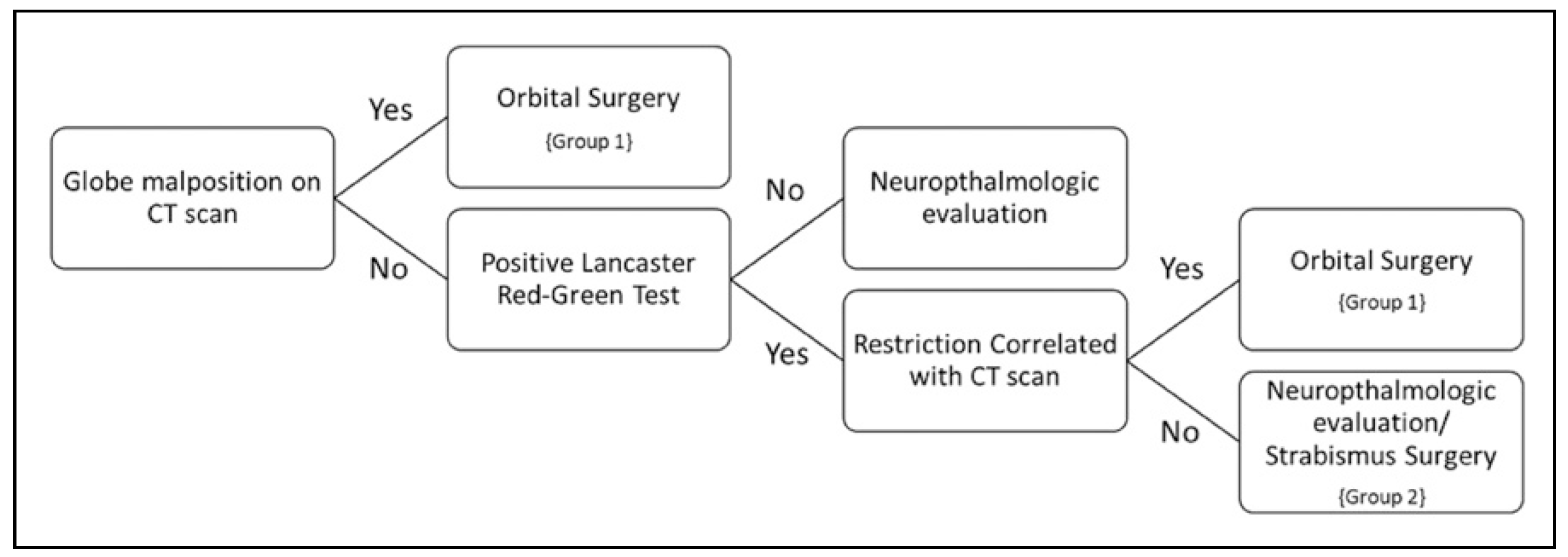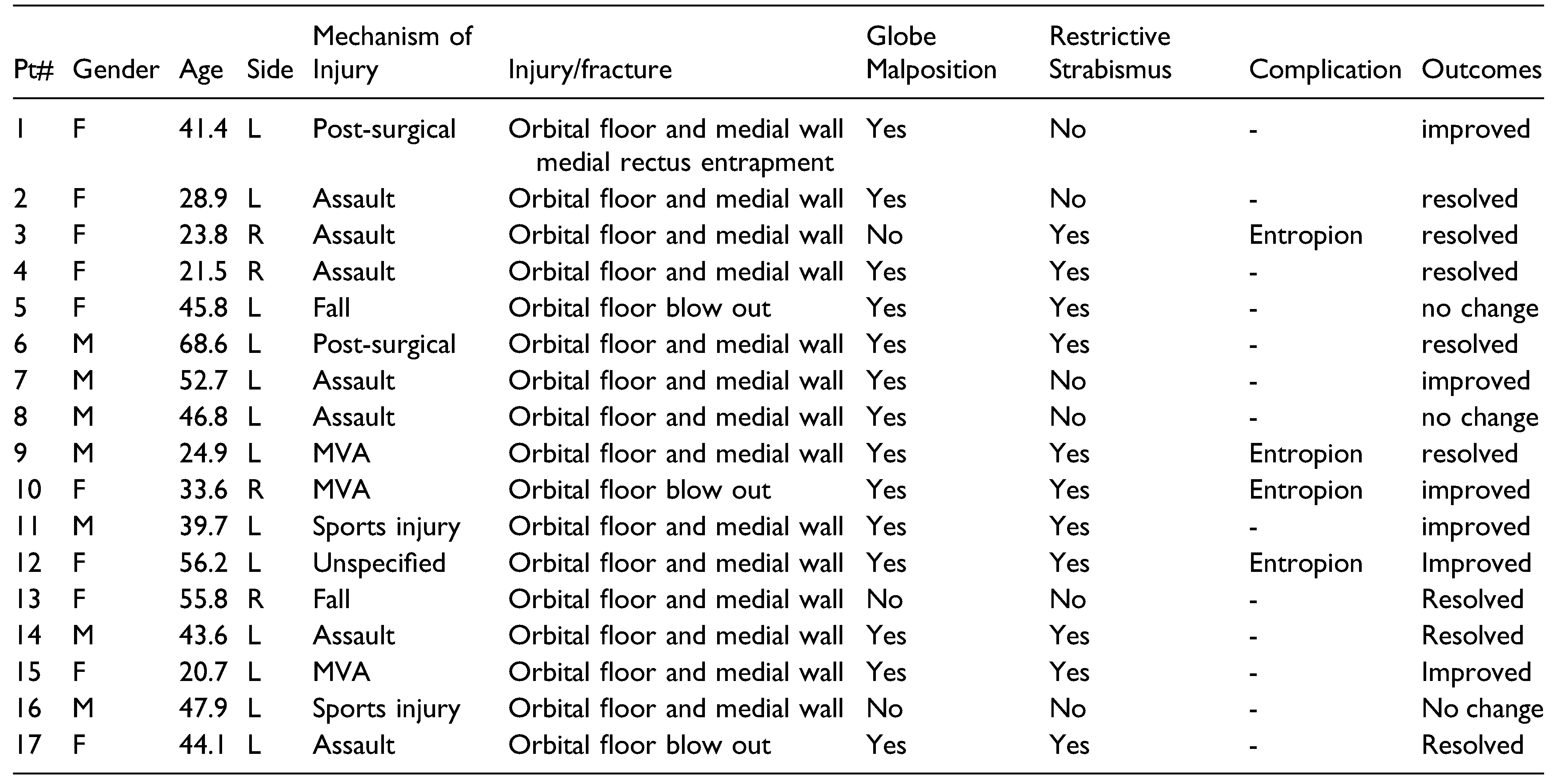Treatment of Persistent Post-Traumatic Diplopia—An Algorithmic Approach to Patient Stratification and Operative Management
Abstract
:Introduction
Methods
Results
Discussion
Funding
Declaration of Conflicting Interests
References
- Ellis, E.; El-Attar, A.; Moos, K.F. An analysis of 2,067 cases of zygomatico-orbital fracture. J Oral Maxillofac Surg. 1985, 43, 417–428. [Google Scholar] [CrossRef] [PubMed]
- Gassner, R.; Tuli, T.; Hächl, O.; Rudisch, A.; Ulmer, H. Craniomaxillofacial trauma: A 10 year review of 9543 cases with 21067 injuries. J Cranio-Maxillofacial Surg. 2003, 31, 51–61. [Google Scholar] [CrossRef]
- Gart, M.S.; Gosain, A.K. Evidence-based medicine: Orbital floor fractures. Plast Reconstr Surg. 2014, 134, 1345e–1355e. [Google Scholar] [CrossRef]
- Young, S.M.; Kim, Y.D.; Kim, S.W.; et al. Conservatively treated orbital blowout fractures: Spontaneous radiologic improvement. Ophthalmology. 2018, 125, 938–944. [Google Scholar] [CrossRef]
- Wen Ying, W.C.; Christoff, A.; Subramanian, P.S.; Eggenberger, E.R. Diplopia and quality of life. Ophthalmology. 2011, 118, 1481. [Google Scholar] [CrossRef]
- Loba, P.; Nowakowska, O.; MarczykW, W.; Sokalska, K.; Broniarczyk-Loba, A. [Diplopia as a factor influencing occupational and social activities of people after orbital trauma]. Med Pr. 2012, 63, 541–546. Available online: http://www.ncbi.nlm.nih.gov/pubmed/23373322.
- Hatt, S.R.; Leske, D.A.; Kirgis, P.A.; Bradley, E.A.; Holmes, J.M. The effects of strabismus on quality of life in adults. Am J Ophthalmol. 2007, 144, 643–647. [Google Scholar] [CrossRef]
- Hawes, M.J.; Dortzbach, R.K. Surgery on orbital floor fractures: Influence of time of repair and fracture size. Ophthalmology. 1983, 90, 1066–1070. [Google Scholar] [CrossRef]
- Biesman, B.S.; Hornblass, A.; Lisman, R.; Kazlas, M. Diplopia after surgical repair of orbital floor fractures. Ophthalmic Plast Reconstr Surg. 1996, 12, 9–16. [Google Scholar] [CrossRef]
- Furuta, M.; Yago, K.; Iida, T. Correlation between ocular motility and evaluation of computed tomography in orbital blowout fracture. Am J Ophthalmol. 2006, 142, 1019–1025. [Google Scholar] [CrossRef]
- Lee, H.B.H.; Nunery, W.R. Orbital adherence syndrome secondary to titanium implant material. Ophthal Plast Reconstr Surg. 2009, 25, 33–36. [Google Scholar] [CrossRef] [PubMed]
- Damgaard, O.E.; Larsen, C.G.; Felding, U.A.; Toft, P.B.; Von Buchwald, C. Surgical timing of the orbital “blowout” fracture: A systematic review and meta-analysis. Otolaryngol Head Neck Surg. 2016, 155, 387–390. [Google Scholar] [CrossRef]
- Yu, D.Y.; Chen, C.H.; Tsay, P.K.; Leow, A.M.; Pan, C.H.; Chen, C.T. Surgical timing and fracture type on the outcome of diplopia after orbital fracture repair. Ann Plast Surg. 2016, 76, S91–S95. [Google Scholar] [CrossRef] [PubMed]
- Mehta, V.J.; Chelnis, J.G.; Chen, Q.; Mawn, L.A. Effect of time to operative intervention on motility outcomes following orbital floor fracture repair in children. Ophthal Plast Reconstr Surg. 2018, 34, 351–354. [Google Scholar] [CrossRef]
- Shah, H.A.; Shipchandler, T.; Vernon, D.; et al. Extra-ocular movement restriction and diplopia following orbital fracture repair. Am J Otolaryngol Head Neck Med Surg. 2018, 39, 34–36. [Google Scholar] [CrossRef]
- Yamanaka, Y.; Watanabe, A.; Sotozono, C.; Kinoshita, S. Impact of surgical timing of postoperative ocular motility in orbital blowout fractures. Br J Ophthalmol. 2018, 102, 398–403. [Google Scholar] [CrossRef]
- Loba, P.; Kozakiewicz, M.; Broniarczyk-Loba, A. Surgical management of upgaze diplopia in patients after posttraumatic orbital floor reconstruction. J Cranio-Maxillofacial Surg. 2015, 43, 976–980. [Google Scholar] [CrossRef]
- Kovar, D.; Voldrich, Z.; Voska, P.; Lestak, J.; Astl, J. Indications for repositioning of blow-out fractures of the orbital floor based on new objective criteria Tissue protrusion volumometry. Biomed Pap. 2017, 161, 403–406. [Google Scholar] [CrossRef]
- Ordon, A.J.; Kozakiewicz, M.; Wilczynski, M.; Loba, P. The influence of concomitant medial wall fracture on the results of orbital floor reconstruction. J Cranio-Maxillofacial Surg. 2018, 46, 573–577. [Google Scholar] [CrossRef]
- Gosse, E.M.; Ferguson, A.W.; Lymburn, E.G.; Gilmour, C.; MacEwen, C.J. Blow-out fractures: Patterns of ocular motility and effect of surgical repair. Br J Oral Maxillofac Surg. 2010, 48, 40–43. [Google Scholar] [CrossRef]
- Balaji, S. Residual diplopia in treated orbital bone fractures. Ann Maxillofac Surg. 2013, 3, 40. [Google Scholar] [CrossRef] [PubMed]
- Hara, J.; Okinaka, Y.; Takahashi, M. Orbital blowout fracture with persistent mobility deficit due to fibrosis of the inferior rectus muscle and perimuscular tissue. Ann Otol Rhinol Laryngol. 1999, 108, 1174–1176. [Google Scholar] [CrossRef]
- Harris, G.J.; Garcia, G.H.; Logani, S.C.; Murphy, M.L. Correlation of preoperative computed tomography and postoperative ocular motility in orbital blowout fractures. Ophthal Plast Reconstr Surg. 2000, 16, 179–187. [Google Scholar] [CrossRef] [PubMed]
- Jin, H.R.; Lee, H.S.; Yeon, J.Y.; Suh, M.W. Residual diplopia after repair of pure orbital blowout fracture: The importance of extraocular muscle injury. Am J Rhinol. 2007, 21, 276–280. [Google Scholar] [CrossRef] [PubMed]
- Xia, Q.; Wang, Z.; Yan, J. Surgical management of strabismus in patients with orbital fracture. J Craniofac Surg. 2018, 29, 1865–1869. [Google Scholar] [CrossRef]
- Campbell, B.C.; Shipchandler, T.Z.; Ting, J.Y.; et al. Ocular motility and diplopia measurements following orbital floor fracture repair. Am J Otolaryngol Head Neck Med Surg. 2021, 42, 102879. [Google Scholar] [CrossRef]

 |
© 2022 by the author. The Author(s) 2022.
Share and Cite
Reddy, S.K.; Colakoglu, S.; Yoon, J.S.; Bhoopalam, M.; Merbs, S.L.; Manson, P.N.; Grant, M.P. Treatment of Persistent Post-Traumatic Diplopia—An Algorithmic Approach to Patient Stratification and Operative Management. Craniomaxillofac. Trauma Reconstr. 2023, 16, 89-93. https://doi.org/10.1177/19433875221083084
Reddy SK, Colakoglu S, Yoon JS, Bhoopalam M, Merbs SL, Manson PN, Grant MP. Treatment of Persistent Post-Traumatic Diplopia—An Algorithmic Approach to Patient Stratification and Operative Management. Craniomaxillofacial Trauma & Reconstruction. 2023; 16(2):89-93. https://doi.org/10.1177/19433875221083084
Chicago/Turabian StyleReddy, Sashank K., Salih Colakoglu, Joshua S. Yoon, Myan Bhoopalam, Shannath L. Merbs, Paul N. Manson, and Michael P. Grant. 2023. "Treatment of Persistent Post-Traumatic Diplopia—An Algorithmic Approach to Patient Stratification and Operative Management" Craniomaxillofacial Trauma & Reconstruction 16, no. 2: 89-93. https://doi.org/10.1177/19433875221083084
APA StyleReddy, S. K., Colakoglu, S., Yoon, J. S., Bhoopalam, M., Merbs, S. L., Manson, P. N., & Grant, M. P. (2023). Treatment of Persistent Post-Traumatic Diplopia—An Algorithmic Approach to Patient Stratification and Operative Management. Craniomaxillofacial Trauma & Reconstruction, 16(2), 89-93. https://doi.org/10.1177/19433875221083084




